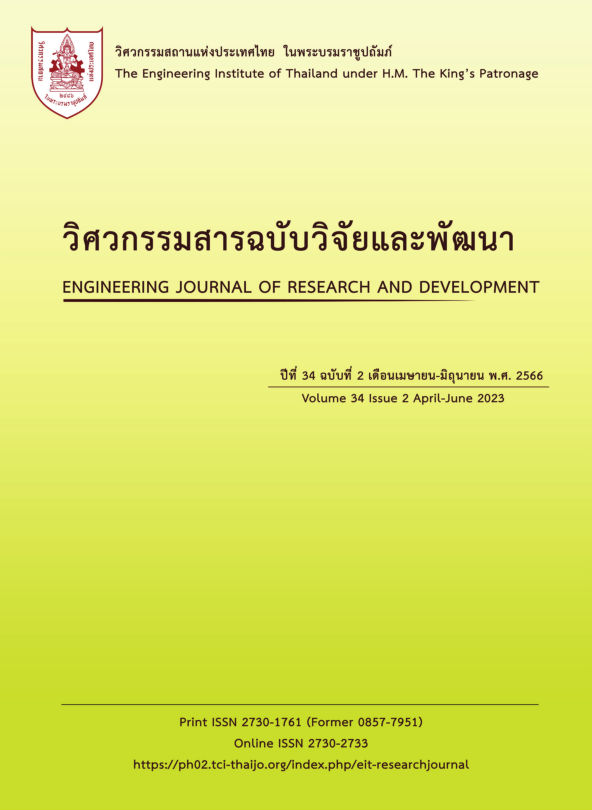THE DEVELOPMENT OF CEMENT-BONDED COMPOSITE BOARD FROM ASEPTIC CARTON WASTE WITH DISTILLERY SLOP
Main Article Content
Abstract
This article presents the development of Cement-Bonded composite board from aseptic carton waste and distillery slop from liquor production. The mechanical, and physical properties of aseptic carton waste cement boards with distillery slop (ACWCBDS) developed were investigated. The ACWCBDS were produced at a density of 1,000 kg/m3. The cement-to-fibers ratios by weight of 70:30. The cement replacement by distillery slop 10 15 20 percent were prepared at the same water-to-cement ratio of 0.6.The size of ACWCBDS is 30 cm in width x 30 cm in length and 2 cm in height. The results of mechanical and physical properties were compared with standards requirements for boards made with wood-based fiber and particle panel materials according to TIS 878-2532 and DIN 1101:1989 consists of modulus of rupture (MOR), modulus of elasticity (MOE), water absorption (WA), thickness swelling (TS), Rate of Burning(ROB) by ASTM D635-98 and Sound Absorption(SOA). Based on the result obtained, it can be summarized that the highest efficiency cement-to-fiber ratio was found to be 70:30 with 10% cement replacement by distillery slop. Possibility to apply for used indoor the building.
Article Details

This work is licensed under a Creative Commons Attribution-NonCommercial-NoDerivatives 4.0 International License.
The published articles are copyright of the Engineering Journal of Research and Development, The Engineering Institute of Thailand Under H.M. The King's Patronage (EIT).
References
Piyarat Paoleng, et al. The Study Of Mechanical And Physical Properties Of Aseptic Carton Waste Cement Bonded Composites Board. in The 1st National Conference on Sustainable Research Development. Bangkok, Thailand. 2011.
Suhasman, Perbandigan Karakteristik Papan Semen Dari Batang Dan Cabang Kayu Asal Hutan Rakyat. Journal Perennail, 2012, 8(1), pp. 30-35.
Suhasman, S., et al., Binderless particleboard resistance to termite attack. Forest Products Journal, 2012, 62 (5), pp. 412-415.
TM, M., Modern Particleboard & Dry-Process Fibre Manufacturing. San Francisco, California: Miller Freeman Publication,1977.
Sukartana P, Rushelia R, and S. IM, Resistance of Wood-And Bamboo Cement Board to Subterranean Termite Coptotermes Gestroi Wasmann (Isoptera: Rhinotermitidae). Wood-Cement Composites in the Asia-Pacific Region.ACIAR Proceedings, 2000 (107), pp. 62-65.
Morteza Khorami and Eshmaiel Ganjian. Comparing flexural behaviour of fibre–cement composites reinforced bagasse: Wheat and eucalyptus. Construction and Building Materials, 2011, 25, pp. 3661-3667.
Ninis Hadi, h. and w. Henry, PURUN TIKUS (ELEOCHARIS DULCIS) FIBER COMPOSITION AS CEMENT BOARD COMPOSITE MATERIAL. Journal of Biodiversity and Environmental Sciences (JBES), 2023, 11 (3), pp. 137-142.
Siriporn Wassanaprasert, Development of plant fiber cement wall for non-air-conditioned buildings, in Architectural. Silpakorn, 2008.
Panutsadee Yenjai, Songklod Jarusombuti, and Teera Veenin, Particleboard Manufacturing from Waste of Cajuput (Melaleuca cajuputiPowell). VRU Research and Development Journal Humanities and Social Science, 2016, 11(2), pp. 131-140.
Kerprasit Pakawat, et al., Development of Particleboard from Northern Black Wattle Tree Bark for Usingas Decorative Materials. Journal of Engineering, RMUTT, 2021, 19 (1), pp. 125-135.
Phonphimon Amornchote, et al., Marketing of Wood Cement Particleboard in Thailand. Thai Journal of Forestry, 2010, 29 (3), pp.45-53.
SCB. Fiber cement exports: how to crack the market? 2017, Available from: https://www.scbeic.com/th/detail/product/3302.
Juthamas Lugsanagid and Nunthachai Chulertsin, Effect of Natural Fibers from Waste Materials on Properties of Cement Fibers Ceiling Boards. Engineering Journal of Research and Development, 2019, 30 (4).
Khumpon, R., The Development of Sustainable Waste Management System for Thailand (Phase) 1. 2012.
Tanakorn Hayim, et al., Environmental Pollution Management of the Local Government Organization. Humanities and social sciences, 2022. 16, (3).
Jaruporn kwaeklam, Utilization of beverage carton waste as reinforcing fibers in concrete., in Civil Engineering. Naresuan University, 2010.
Nadir Ayrilmisa, Z., Salim Hiziroglub,, Physical and mechanical properties of cardboard panels made from used beverage carton with veneer overlay. Materials and Design, 2008, 29, PP.1897-1903.
Georgiopoulou, I., et al., Recycling of post-consumer multilayer Tetra Pak® packaging with the Selective Dissolution-Precipitation process. Resources, Conservation and Recycling, 2021, 165, pp. 105268.
Ratchada Lakool and W. Phoochinda, Guidelines for Utilization of Distillery Slop from Liquor Production for Factory. Rajabhat Rambhai Barni Research Journal, 2020, 14 (1).
Thai Industrial Standard: 878-2532, Cement Bonded Particleboards: High Density.
Deutsches Institut für Normung: 1101: 1989, DIN 1101: 1989 – Wood wool slabs and sandwich composite panels for use as insulating materials – Requirements and testing.
Joseph AdeolaFuwape, James Sunday Fabiyi and Edward Olusola Osuntuyi, Technical assessment of three-layered cement-bonded boards produced from wastepaper and sawdust. Waste Management, 2007, 27, pp.1611-1616.
Pusit Lertwattanaruk and Kanokwan Masuwan, Investigation of Sound Insulation Properties of Fiber Cement Board Containing Natural Fibers. KMUTT Research and Development Journal, 2013, 38 (1), pp. 71-86.
Pramote Weranugul and Kittiphong Suveero, Development of Cement Boards with Ground Coffee for Environment Conservation. Faculty of Industrial Education, 2013.
Rattapoohm Parichartprecha, Piyarat Paoleng, and Thanaphon Penrat. Mechanical Properties of Cement-Bonded Composite Board Produced from Aseptic Carton Waste. in International Conference on sustainable construction Materials & Technologies: SCMT3. 2013. Kyoto.
ASTM D 635 – 03, 1998. Standard Test Method for Rate of Burning and/or Extent and Time of Burning of Plastics in a Horizontal Position1.


